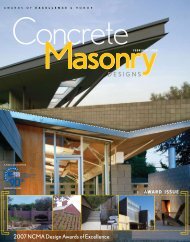to view article - Sutter Masonry
to view article - Sutter Masonry
to view article - Sutter Masonry
You also want an ePaper? Increase the reach of your titles
YUMPU automatically turns print PDFs into web optimized ePapers that Google loves.
An information series from the national authority on concrete masonry technologyASTM SPECIFICATIONS FORCONCRETE MASONRY UNITSTEK 1-1FCodes & Specs (2012)INTRODUCTIONThe most widely-used standards for specifying concretemasonry units in the United States are published by ASTMInternational. These ASTM standards contain minimumrequirements that assure properties necessary for qualityperformance. These requirements include items such specifiedcomponent materials, compressive strength, permissiblevariations in dimensions, and finish and appearance criteria.Currently, seven ASTM standards apply <strong>to</strong> units intendedprimarily for construction of concrete masonry walls, beams,columns or specialty applications (see Table 1).The letter and first number of an ASTM designationis the fixed designation for that standard. For example,ASTM C55 is the fixed designation for concrete buildingbrick. The number immediately following indicates theyear of last revision (i.e., ASTM C55-11 is the version ofC55 published in 2011). A date in parentheses after the lastrevision date is the reapproval date.Because significant changes can be introduced in<strong>to</strong>subsequent editions, the edition referenced by the buildingcode or by a project specification can be an important considerationwhen determining specific requirements. Also notethat it may take several years between publication of a newASTM standard and its subsequent reference by a buildingcode. For this reason, Table 1 includes the editions referencedin the 2006, 2009 and 2012 editions of the InternationalBuilding Code (IBC) (ref. 1), as well as the most currentASTM edition. Code officials will commonly accept morecurrent editions of ASTM standards than that referenced inthe code, as they represent state-of-the-art requirements.LOADBEARING CONCRETE MASONRYUNITS— ASTM C90As the most widely-referenced ASTM standard forconcrete masonry units, ASTM C90 is under continuousre<strong>view</strong> and revision. The bulk of these revisions are edi<strong>to</strong>rial,although two recent major changes are discussed here.In 2011, web thickness requirements were significantlyrevised. Prior <strong>to</strong> ASTM C90-11b (ref. 3), there were differentminimum web thicknesses based on unit width.Additionally, equivalent web thickness, a measure of thewidth of web per foot of wall length was used <strong>to</strong> determineType of unitTable 1—ASTM Specifications for Concrete <strong>Masonry</strong> UnitsASTMdesignationEdition referenced in:the 2009IBCthe 2006IBCthe 2012IBCMost current editionConcrete Building Brick C55 C55-03 C55-06e 1 C55-06e 1 C55-11Calcium Silicate Brick C73 C73-99a C73-05 C73-05 C73-10Loadbearing Concrete <strong>Masonry</strong> Units C90 C90-03 C90-06b C90-08 C90-11bNonloadbearing Concrete <strong>Masonry</strong> Units C129 C129-01 A C129-05 A C129-06 A C129-11Catch Basin and Manhole Units C139 N/A B N/A B N/A B C139-11Prefaced Concrete Units C744 C744-99 C744-05 C744-08 C744-11Concrete Facing Brick C1634 N/A B N/A B N/A B C1634-11AAlthough not directly referenced in the IBC, C129 is referenced in Specification for <strong>Masonry</strong> Structures (ref. 2)BThis standard is not referenced in the IBC.Related TEK:10-2C, 10-3, 14-22Keywords: absorption, ASTM specifications, calcium silicate brick,compressive strength, concrete brick, dimensions, face shell and web thickness,gross area, net area, specifications, testing, water absorptionNCMA TEK 1-1F 1



